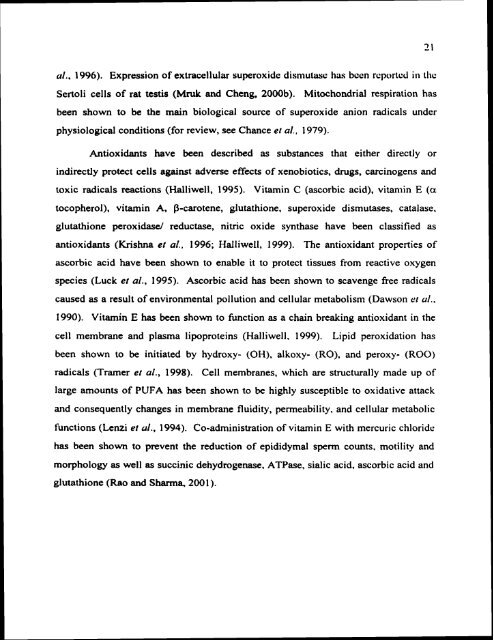ON TESTIS AND EPlDlDYMlS OF RATS - Pondicherry University ...
ON TESTIS AND EPlDlDYMlS OF RATS - Pondicherry University ...
ON TESTIS AND EPlDlDYMlS OF RATS - Pondicherry University ...
Create successful ePaper yourself
Turn your PDF publications into a flip-book with our unique Google optimized e-Paper software.
01.. 1996). Expression of extracellular superoxidc dismutasc has bccn rcportcd in the<br />
Sertoli cells of rat testis (Mruk and Cheng, 2000b). Mitochondria1 respiration has<br />
been shown to be the main biological source of superoxide anion radicals under<br />
physiological conditions (for review, see Chance er a/. 1979).<br />
Antioxidants have been described as substances that either directly or<br />
indirectly protect cells against adverse effects of xenobiotics, drugs, carcinogens and<br />
toxic radicals reactions (Halliwell, 1995). Vitamin C (ascorbic acid), vitamin E (a<br />
tocopherol), vitamin A, p-carotene, glutathione, superoxide dismutases, catalase,<br />
glutathione peroxidasel reductase, nitric oxide synthase have been classified as<br />
antioxidants (Krishna er a/.. 1996; Halliwell, 1999). The antioxidant properties of<br />
ascorbic acid have been shown to enable it to protect tissues from reactive oxygen<br />
species (Luck ef a/., 1995). Ascorbic acid has been shown to scavenge free radicals<br />
caused as a result of environmental pollution and cellular metabolism (Dawson er 01..<br />
1990). Vitamin E has been shown to function as a chain breaking antioxidant in the<br />
cell membrane and plasma lipoproteins (Halliwell. 1999). Lipid peroxidation has<br />
been shown to be initiated by hydroxy- (OH). alkoxy- (RO), and peroxy- (ROO)<br />
radicals (Tramer el al., 1998). Cell membranes, which are structurally made up of<br />
large amounts of PUFA has been shown to be highly susceptible to oxidative attack<br />
and consequently changes in membrane fluidity, permeability. and cellular metabolic<br />
functions (Lenzi el 01.. 1994). Co-administration of vitamin E with mercuric chloride<br />
has been shown to prevent the reduction of epididymal sperm counts, motility and<br />
morphology as well as succinic dehydrogenase, ATPase, sialic acid. ascorbic acid and<br />
glutathione (Rao and Sharrna 2001).

















